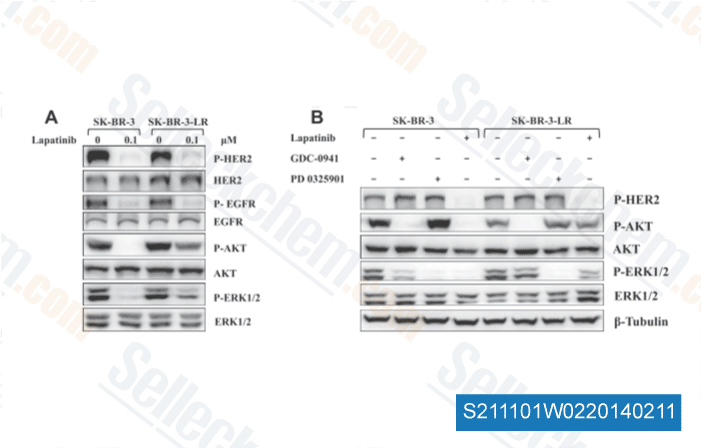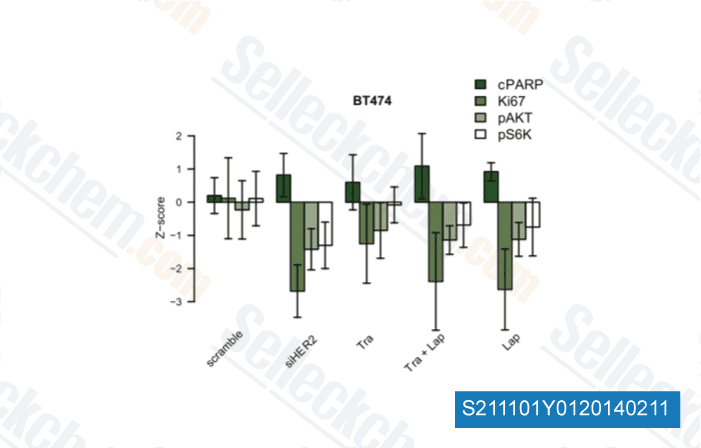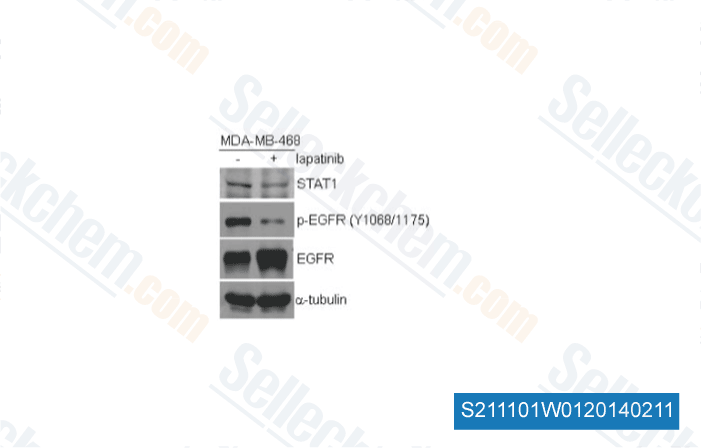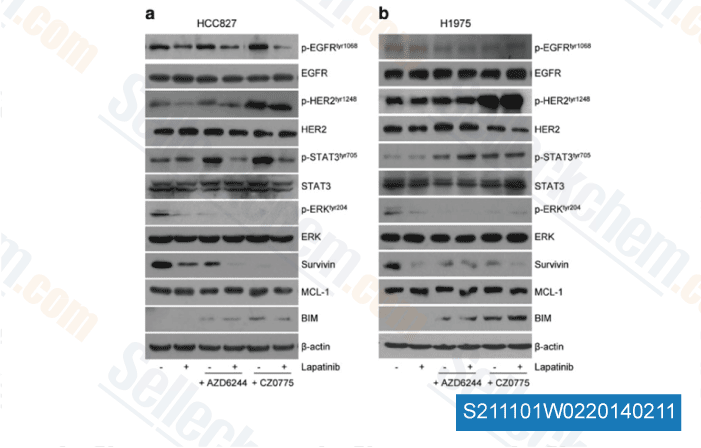|
Toll Free: (877) 796-6397 -- USA and Canada only -- |
Fax: +1-832-582-8590 Orders: +1-832-582-8158 |
Tech Support: +1-832-582-8158 Ext:3 Please provide your Order Number in the email. |
Technical Data
| Formula | C29H26ClFN4O4S |
|||
| Molecular Weight | 581.06 | CAS No. | 231277-92-2 | |
| Solubility (25°C)* | In vitro | DMSO | 100 mg/mL (172.09 mM) | |
| Water | Insoluble | |||
| Ethanol | Insoluble | |||
|
* <1 mg/ml means slightly soluble or insoluble. * Please note that Selleck tests the solubility of all compounds in-house, and the actual solubility may differ slightly from published values. This is normal and is due to slight batch-to-batch variations. * Room temperature shipping (Stability testing shows this product can be shipped without any cooling measures.) |
||||
Preparing Stock Solutions
Biological Activity
| Description | Lapatinib is a potent EGFR and ErbB2 inhibitor with IC50 of 10.8 and 9.2 nM in cell-free assays, respectively. Lapatinib induces ferroptosis and autophagic cell death. | ||||||
|---|---|---|---|---|---|---|---|
| Targets |
|
||||||
| In vitro | Lapatinib weakly inhibits the activity of ErbB4 with IC50 of 367 nM, and displays >300-fold selectivity for EGFR and ErbB2 over other kinases such as c-Src, c-Raf, MEK, ERK, c-Fms, CDK1, CDK2, p38, Tie-2, and VEGFR2. Lapatinib significantly inhibits receptor autophosphorylation of EGFR and ErbB2 in a dose-dependent manner with IC50 of 170 nM and 80 nM, respectively in HN5 cells; as well as 210 nM and 60 nM, respectively in BT474 cells. Unlike OSI-774 and Iressa (ZD1839) which preferentially inhibit the growth of the EGFR-overexpressing cells, Lapatinib inhibits the growth of both EGFR- and ErbB2-overexpressing cells. Lapatinib displays higher inhibitory activity against EGFR- or ErbB2-overexpressing cells with IC50 of 0.09-0.21 μM, compared with cells expressing low levels of EGFR or ErbB2 with IC50 of 3-12 μM, and exhibits ~100-fold selectivity over the normal fibroblast cells. Lapatinib potently inhibits the outgrowth of EGFR-overexpressing HN5 and A-431 cells, as well as ErbB2-overexpressing BT474 and N87 cells, and significantly induces G1 arrest of HN5 cells and apoptosis of BT474 cells, which are associated with inhibition of AKT phosphorylation. [1] | ||||||
| In vivo | Oral administration of Lapatinib (~100 mg/kg) twice daily significantly inhibits the growth of BT474 and HN5 xenografts in a dose-dependent manner. [1] |
Protocol (from reference)
| Kinase Assay:[1] |
|
|---|---|
| Cell Assay:[1] |
|
| Animal Study:[1] |
|
Customer Product Validation

-
Data from [Cancer Lett, 2013, 340(1), 43-50]

-
Data from [Mol Oncol, 2013, 7(3), 392-401]

-
Data from [Mol Carcinog, 2013, 52(12), 959-69]

-
Data from [Acta Pharmacol Sin, 2013, 10.1038/aps.2013.124]
Selleck's Lapatinib has been cited by 542 publications
| Circulating tumor cell plasticity determines breast cancer therapy resistance via neuregulin 1-HER3 signaling [ Nat Cancer, 2025, 6(1):67-85] | PubMed: 39753722 |
| CD36 enrichment in HER2-positive mesenchymal stem cells drives therapy refractoriness in breast cancer [ J Exp Clin Cancer Res, 2025, 44(1):19] | PubMed: 39833955 |
| Sotorasib resistance triggers epithelial-mesenchymal transition and activates AKT and P38-mediated signaling [ Front Mol Biosci, 2025, 12:1537523] | PubMed: 39950162 |
| Tumor-acquired somatic mutation affects conformation to abolish ABCG2-mediated drug resistance [ Drug Resist Updat, 2024, 73:101066] | PubMed: 38387283 |
| RAB22A sorts epithelial growth factor receptor (EGFR) from early endosomes to recycling endosomes for microvesicles release [ J Extracell Vesicles, 2024, 13(7):e12494] | PubMed: 39051763 |
| Proteogenomic analysis dissects early-onset breast cancer patients with prognostic relevance [ Exp Mol Med, 2024, 56(11):2382-2394] | PubMed: 39482530 |
| EGFR and HER2 hyper-activation mediates resistance to endocrine therapy and CDK4/6 inhibitors in ER+ breast cancer [ Cancer Lett, 2024, 593:216968] | PubMed: 38788968 |
| Cell-specific models reveal conformation-specific RAF inhibitor combinations that synergistically inhibit ERK signaling in pancreatic cancer cells [ Cell Rep, 2024, 43(9):114710] | PubMed: 39240715 |
| Her2 promotes early dissemination of breast cancer by inhibiting the p38 pathway through the downregulation of MAP3K4 [ Cell Commun Signal, 2024, 22(1):611] | PubMed: 39702199 |
| Targeting rapid TKI-induced AXL upregulation overcomes adaptive ERK reactivation and exerts antileukemic effects in FLT3/ITD acute myeloid leukemia [ Mol Oncol, 2024, 10.1002/1878-0261.13749] | PubMed: 39395205 |
RETURN POLICY
Selleck Chemical’s Unconditional Return Policy ensures a smooth online shopping experience for our customers. If you are in any way unsatisfied with your purchase, you may return any item(s) within 7 days of receiving it. In the event of product quality issues, either protocol related or product related problems, you may return any item(s) within 365 days from the original purchase date. Please follow the instructions below when returning products.
SHIPPING AND STORAGE
Selleck products are transported at room temperature. If you receive the product at room temperature, please rest assured, the Selleck Quality Inspection Department has conducted experiments to verify that the normal temperature placement of one month will not affect the biological activity of powder products. After collecting, please store the product according to the requirements described in the datasheet. Most Selleck products are stable under the recommended conditions.
NOT FOR HUMAN, VETERINARY DIAGNOSTIC OR THERAPEUTIC USE.
